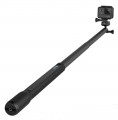Tripod transformation
Possibility
of converting a selfie tripod into a classic tripod that can be mounted on any suitable surface. Note that this can be either a classic, floor tripod, or a desktop structure, a clamp, etc. And the transformation itself can be carried out in different ways. However, anyway, by purchasing a model with this function, you can do without buying a separate tripod (although such designs are still not suitable for complex tasks).
Minimum length
The length of the monopod when folded. First of all, ease of transportation depends on this parameter, although a fully folded design can also be used when shooting. It is also worth mentioning that a smaller folded length (for the same maximum length) can mean more sections, which complicates the design, increases its cost and somewhat reduces reliability.
The most compact modern selfie sticks when folded take
less than 15 cm, the largest ones can have a minimum length of
more than 30 cm(this is an inevitable consequence of the large overall length).
Maximum length
The longest length that the monopod can be extended to.
Longer length allows you to place the camera further away from the user and fit more space into the frame. It can also be useful when shooting in hard-to-reach places where you can’t just reach with your hand. Also, with the same minimum length, a larger maximum length means a wider range of distances available for a given tripod. On the other hand, the working size of the structure significantly affects its weight and price.
If we talk about specific numbers, then the shortest modern selfie sticks are up
to 50 cm long. A value of
51 – 75 cm is considered average,
76 – 100 cm is more than average, and in the longest models they can expand to
1 m or more.
Head type
The type of tripod head depends on the type of mechanism that provides head rotation and tilt.
— 2D. Designs in which two separate axes are provided — for turning the head to the right and left and for tilting back and forth. Such heads are more complicated and more expensive than ball heads, but much more reliable, they are less prone to spontaneous shift. And in models with the ability to convert to a tripod (see above), 2D heads provide another advantage — they allow you to shoot by moving the camera strictly vertically or strictly horizontally.
—
Ball. The platform in such heads is attached to the ball, clamped in a special mount (hence the name); by loosening the mount, you can arbitrarily change the position of the camera along any of the axes. Ball heads are considered a low-cost option: they are inexpensive and easy to use, but they are inferior to 2D mechanisms in terms of retention.
Adjustable leg
The presence of an adjustable leg in the design of the tripod.
Adjustable legs are called rods that do not expand telescopically, but are laid out on swivel mounts — in such a way that in a semi-unfolded (and sometimes fully unfolded) position, the structure has the shape of a zigzag. This feature gives some specific features that are not available for conventional telescopic rods, however, it makes it somewhat difficult to fine-tune the distance to the camera.
Fixed sections
The presence
of sections with special clamps in the design of the tripod.
The normal section for fixing in one position must be fully extended; this is not always convenient. The latches also allow you to fix the sections in any position, not necessarily fully extended. Thus, you can set almost any length of the rod (ranging from minimum to maximum). The disadvantages of such models are the high price and slightly increased weight.
End thread
The presence
of a threaded socket in the design of the tripod.
Such a socket is usually located at the end, on the opposite side from the smartphone / camera mount. It can be used both for mounting various accessories (for example, a folding tripod for transformation into a tripod), and for mounting the rod itself on other structures (for example, a traditional photo tripod). The thread, usually, has a standard size, but this size still needs to be specified separately.
Material
The main material used in the construction of the tripod, more precisely, the tripod rods (other materials can be used for the handle and head, for example, a plastic or leather overlay on a metal rod).
—
Metal. The metal found in selfie tripods can have different compositions and properties: for example, steel costs relatively little but is heavy, aluminium is light but expensive, and so on. Anyway, the advantage of this option over plastic is its high strength, which allows you to create structures for almost any camera weight (up to several kilograms).
—
Plastic. Inexpensive and fairly light material, plastic has fairly good strength, but is noticeably inferior to metals in terms of reliability. Therefore, this option is somewhat less common, mainly in tripods with a small maximum load.

